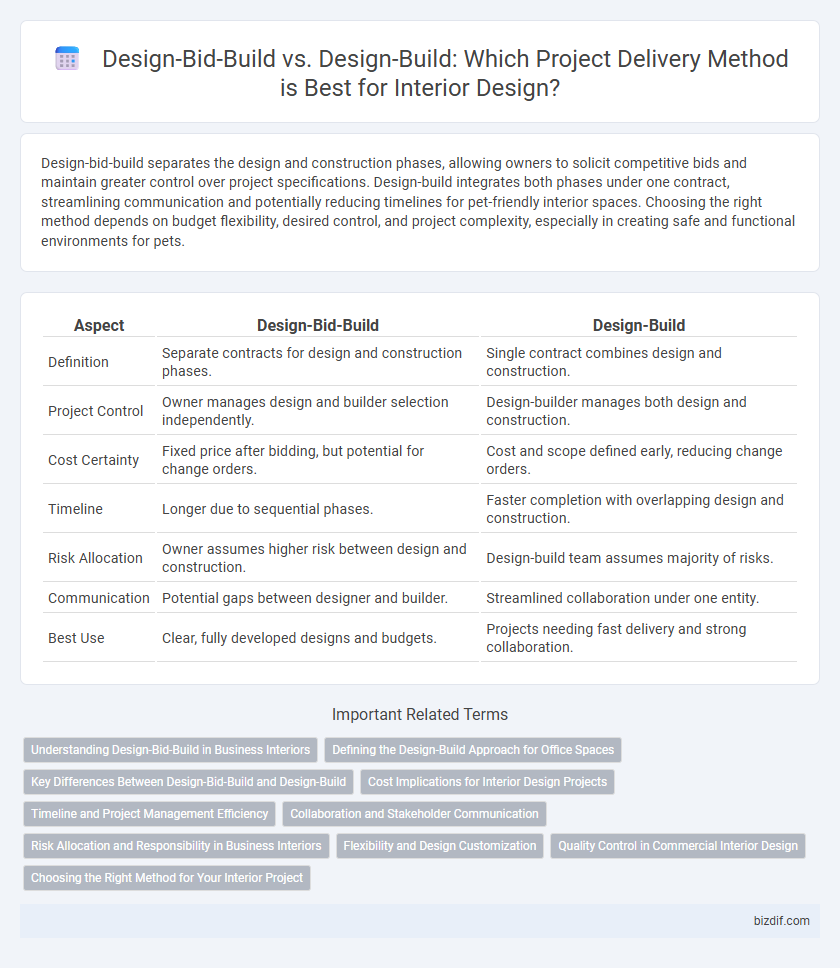Design-bid-build separates the design and construction phases, allowing owners to solicit competitive bids and maintain greater control over project specifications. Design-build integrates both phases under one contract, streamlining communication and potentially reducing timelines for pet-friendly interior spaces. Choosing the right method depends on budget flexibility, desired control, and project complexity, especially in creating safe and functional environments for pets.
Table of Comparison
| Aspect | Design-Bid-Build | Design-Build |
|---|---|---|
| Definition | Separate contracts for design and construction phases. | Single contract combines design and construction. |
| Project Control | Owner manages design and builder selection independently. | Design-builder manages both design and construction. |
| Cost Certainty | Fixed price after bidding, but potential for change orders. | Cost and scope defined early, reducing change orders. |
| Timeline | Longer due to sequential phases. | Faster completion with overlapping design and construction. |
| Risk Allocation | Owner assumes higher risk between design and construction. | Design-build team assumes majority of risks. |
| Communication | Potential gaps between designer and builder. | Streamlined collaboration under one entity. |
| Best Use | Clear, fully developed designs and budgets. | Projects needing fast delivery and strong collaboration. |
Understanding Design-Bid-Build in Business Interiors
Design-bid-build is a traditional project delivery method in business interiors where the design and construction phases are separated, with competitive bidding used to select contractors. This approach offers clear contractual boundaries and can lead to cost transparency but may result in longer timelines due to sequential processes. Understanding design-bid-build helps businesses manage risks and maintain control over design quality and budget before construction begins.
Defining the Design-Build Approach for Office Spaces
The design-build approach for office spaces integrates architecture, engineering, and construction within a single contract, streamlining communication and accelerating project timelines. This method enhances collaboration between designers and contractors, resulting in faster decision-making and reduced costs compared to the traditional design-bid-build process. Emphasizing cohesive project delivery improves flexibility in adapting interior layouts to evolving workplace needs and technological advancements.
Key Differences Between Design-Bid-Build and Design-Build
Design-bid-build separates the design and construction phases, requiring a client to hire an architect first, then bid out the project to contractors, which can lead to longer timelines and potential communication gaps. Design-build integrates design and construction in a single contract, enhancing collaboration, reducing project duration, and providing cost certainty early in the process. Key differences include project delivery speed, accountability consolidation under one entity in design-build, and increased potential for cost overruns in design-bid-build due to separated contracts.
Cost Implications for Interior Design Projects
Design-bid-build projects typically incur higher overall costs due to separate contracts for design and construction, leading to increased administrative expenses and potential change orders. Design-build streamlines the process by integrating design and construction services, often resulting in reduced project timelines and lower costs through enhanced collaboration and risk mitigation. Interior design projects benefit from design-build's cost efficiency by minimizing budget overruns and ensuring cohesive communication between designers and contractors.
Timeline and Project Management Efficiency
Design-build integrates design and construction under one contract, significantly reducing the overall project timeline and streamlining project management by fostering collaboration between architects and contractors from the start. Design-bid-build separates design and construction phases, often causing longer timelines due to sequential processing and potential miscommunications between designers and builders. Project management efficiency in design-build improves decision-making speed and coordination, minimizing delays common in design-bid-build projects.
Collaboration and Stakeholder Communication
Design-bid-build separates design and construction phases, often limiting collaboration between architects, contractors, and clients, which can result in communication gaps and project delays. Design-build integrates design and construction teams, fostering continuous collaboration and real-time stakeholder communication that enhances project efficiency and alignment with client goals. This unified approach streamlines decision-making, reduces conflicts, and improves overall project outcomes in interior design projects.
Risk Allocation and Responsibility in Business Interiors
Design-bid-build separates design and construction phases, placing risk predominantly on the owner who coordinates between architects and contractors. Design-build integrates design and construction under a single entity, streamlining communication and transferring most risk to the design-build firm. For business interiors, design-build reduces liability disputes and accelerates project delivery by centralizing responsibility, while design-bid-build offers clear contractual roles but increased potential for misaligned risk and cost overruns.
Flexibility and Design Customization
Design-bid-build offers more flexibility in design customization by allowing clients to make changes during the design phase before bidding, ensuring tailored project outcomes. In contrast, design-build integrates design and construction, which streamlines communication but may limit design modifications once the process begins. Clients seeking extensive design personalization often prefer design-bid-build for its segmented approach and enhanced adaptability.
Quality Control in Commercial Interior Design
Design-bid-build often leads to fragmented accountability in quality control due to separate contracts for design and construction, increasing the risk of miscommunication and inconsistencies in commercial interior design projects. Design-build integrates design and construction teams under one contract, enhancing collaboration and enabling continuous quality monitoring throughout the project lifecycle. This unified approach typically results in higher adherence to design specifications and improved overall quality in commercial interior environments.
Choosing the Right Method for Your Interior Project
Selecting between Design-bid-build and Design-build methods depends on project complexity, budget, and timeline constraints. Design-bid-build offers clear separation of design and construction phases, ideal for detailed planning and competitive bids, while Design-build integrates both, enabling faster completion and streamlined communication. Evaluating your interior project's scope and risk tolerance ensures the optimal approach for quality and efficiency.
Design-bid-build vs Design-build Infographic

 bizdif.com
bizdif.com